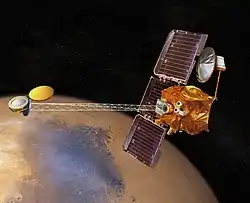Mars Exploration Ice Mapper
The Mars Exploration Ice Mapper is a proposed Mars Orbiter being developed by NASA in collaboration with the Canadian Space Agency. The goal of the orbiter is the quantification of extent and volume of water ice in non-polar regions of Mars. The results are intended to support future Mars missions, especially with respect to the search for habitable environments and accessible ISRU resources. The planned launch date of the mission is 2026.[1]
| Mission type | Mars orbiter |
|---|---|
| Operator | NASA · CSA |
| Mission duration | Planned: 2 years |
| Start of mission | |
| Launch date | 2026 (planned) |
| Orbital parameters | |
| Reference system | Areocentric |
| Regime | Circular |
| Periareion altitude | 250–320 km (160–200 mi) |
| Apoareion altitude | 250–320 km (160–200 mi) |
| Inclination | 74 degrees |
| Period | 110 minutes |
| Epoch | Planned |
Objectives
The mission plans to scan specific locations on the Martian surface below 2 km elevation (to enable entry, descent and landing). The target areas for radar scans are between 25° and 40° northern latitude and 25° and 40° southern latitude. The upper limit of 40° was chosen to have favorable conditions for solar arrays. The lower bound of 25° is intended to maximize the proximity of locating ground ice (since availability of ground ice generally decreases toward the equator due to increased insolation).[1]
Instrument
The mission concept plans to utilize Synthetic-aperture radar, based on technology used by the Canadian RADARSAT satellite constellation.[1]
The radar has the following technical specification: [1]
- Frequency: 900 MHz
- Antenna: Parabolic antenna with 6 meters diameter deployed on orbit
- Energy consumption: between 500 and 1000 Watts
- Polarization: hybrid (circular transmit, dual linear reception)
- Two modes: SAR mode and Sounder mode
- SAR mode: map swath width 30 km, penetration depth 6m
- Sounder mode: vertical resolution 1m, along-track resolution: 30m, across-track resolution: 1,5 km
See also
References
- Jim Watzin and Tim Haltigin (15 April 2020). "Mars Exploration Ice Mapper" (PDF).

.jpg.webp)
.jpg.webp)